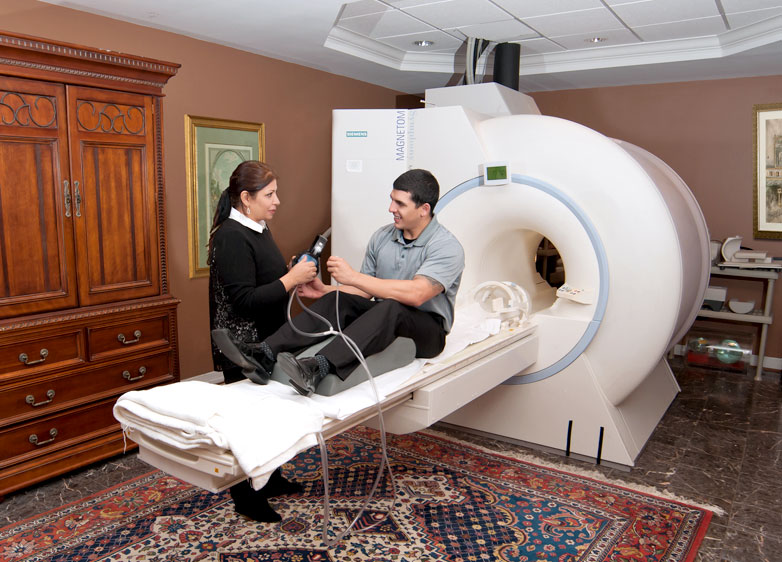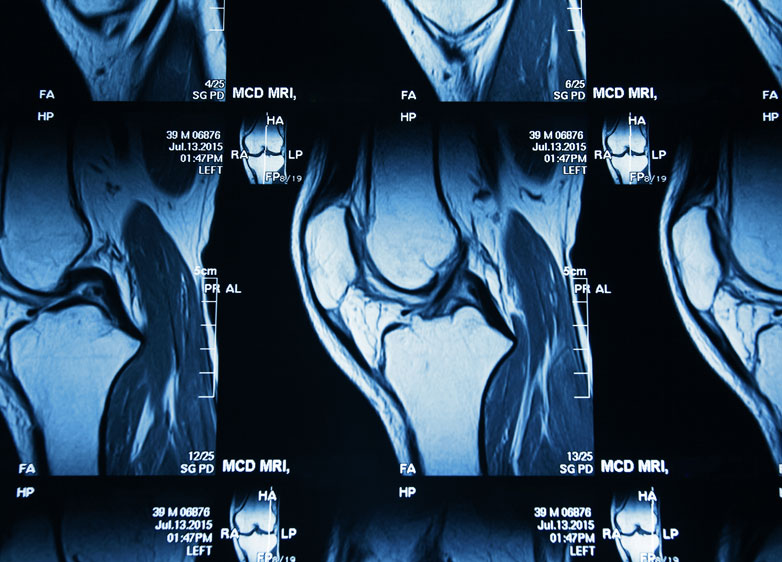MRI

Patients needing an MRI can expect friendly care from the team at GO Imaging. Your comfort and peace of mind are our priority when you undergo diagnostic imaging in our Houston or Humble facilities.
Open MRI available at our Humble location to accommodate claustrophobia and patients that have been unable to complete an MRI in a closed magnet.
What Is MRI?
MRI, or Magnetic Resonance Imaging, is a non-invasive method of diagnostic testing that we use to obtain important health data. This imaging technology is based on radio frequency and a powerful magnetic field. Go Imaging conducts an MRI to observe a variety of internal structures, ranging from bone to soft-tissue organs.
There is no ionizing radiation exposure during magnetic resonance imaging.
Reasons for an MRI Scan
MRI may be conducted to evaluate a number of structures:
- Brain and spine.
- Lymph nodes.
- Blood vessels.
- Reproductive and pelvic organs, such as the prostate and the uterus.
- Bodily organs such as the pancreas, liver, adrenal glands, and heart.
- Joints and bones.
MRI may be used to diagnose or monitor:
- Bone infection or tumors.
- Abnormalities in spinal disc or discs.
- Vasculitis (blood vessel inflammation) or malformed blood vessels.
- Crohn’s disease and other bowel inflammation.
- Abnormalities of the pancreas or bile ducts.
- Liver disease, cirrhosis.
- Pelvic, abdominal, or chest tumors.

MRI Procedure
MRI uses radio waves and a strong magnetic field to acquire data that we send to a computer that processes the images. A patient lies on a table head or feet first depending on the body part we are scanning. There is always some type of antenna or “coil” that goes around the body part being scanned. This area is then centered inside the scanner. Since a loud banging is associated with scanning, the technologist will offer earplug or headphones to the patient. Our staff can provide dressing gowns or “scrubs” if needed. Most scans last from 20 to 60 minutes. It is very important to remain still throughout the exam so that the exam time is not extended.
If necessary, we will administer contrast material intravenously. This may take place after an initial round of imaging without contrast. Few patients experience slight pain at the injection site or nausea in response to contrast material. Allergic reaction to this product is rare. The onset of itching or hives should be reported to the technologist.
The MRI technologist obtains images via a computer located outside the imaging room but maintains a clear line of sight to the table. Once we obtain all the images, we will asses them for clarity, and then release the patient.
Open MRI vs Closed MRI
The closed MRI machine is the standard of practice that has been used for several years. This machine is designed in a tube form. During the screening, the table on which the patient lies is moved into the magnetized tunnel for a short time. The enclosed shape of this scanner extends the options for observation of various areas of the body.Closed MRI scanners are advantageous for the strength, or power, of magnetic imaging. Magnetic power is measured in teslas, or T. Closed scanners range from .5 to 3.0 T, which means greater accuracy for structures that may be more difficult to observe.
The primary disadvantage of the closed MRI is the sense of claustrophobia that some patients may experience during their scan. Due to apprehension and anxiety, patients may find it difficult to lie completely still for the duration of screening. The may discuss the use of a mild sedative with the ordering physician. Open MRI scanners have two “panels” on which strong magnets are situated. We position one panel over the table and one beneath. The sides of the scanner are open.
Advantages and Disadvantages of Open MRI
Many patients express a preference for open MRI screening due to the greater comfort they may feel with the open-sided design of the scanner. This situation may also be more comfortable for larger patients who prefer more physical space.
Disadvantages of open MRI include lower T strength, which decreases the options in imaging various parts of the body. For this reason, we may not be able to accommodate the desire for open MRI screening.
Preparing for an MRI
It is necessary to remove all jewelry or other metallic items. This includes body piercings, metal zippers or hairpins, hearing aids, and watches. It is best to dress in pull-on pants or shorts without zippers and leave all jewelry at home.
The technologist needs to know if any electronic medical devices or metal are in your body, such as metal pins or stents, metal joint prosthesis, or artificial heart valves. These may interfere with the imaging process, or cause risk to the patient.
Does an MRI Hurt?
There is no pain associated with MRI imaging. However, few patients describe a warming sensation in the area that we image. Patients may also hear a prominent thumping or tapping as the machine records images. To reduce auditory sensation and improve comfort, you may use earplugs or other noise-reducing equipment.
How Is MRI Different from CT Scan and X-ray?
Magnetic Resonance Imaging, Computed Tomography, and X-ray imaging are all valuable diagnostic tools to which there are more benefits than risk. Each obtains high-quality data using a particular form of energy. CT scans and X-rays work by highlighting internal structures with radiation, forming a 2-dimensional image. Magnetic Resonance records structures in 2-dimensional or 3-dimensional cross-section fragments, using a magnetic field and radio frequency.
Our specialized team of radiologists and X-ray, CT scan, and MRI technologists and support also have the high-level education and training needed to supply referring physicians with pertinent information to facilitate the appropriate exam for each patient.

When Will I Get My Results from My MRI?
Images obtained through MRI screening must be interpreted by a radiologist. This typically takes place within a day or two, depending on the timing of the test itself. Once the radiologist analyzes the images, they will send a report to the ordering physician. The physician’s office will contact you as soon as they have your results.
Patient Testimonial
My husband came into your facility for an MRI. He had a ruptured disc and was in a great deal of pain. We were impressed by how homey and comfortable your facility is, but we were more impressed by how caring your staff is. When my husband had to be taken in for the MRI, (the technologist) asked me if I wanted to accompany him and then saw to it that he position a comfortable Queen Anne chair right next to the MRI table so that I could be there next to my husband. I hope that we shall never need another MRI, but in the event that we do, or anyone we know does, we will certainly encourage them to make use of your facility. Thank you for your kind care.
-Peggy C.
To read more, visit our testimonial page.
MRI Risks
• Pacemaker
• Intrauterine contraceptive device
• Cochlear implants
• Drug infusion pump
• Prosthetic devices including metal plates, pins, clips, etc.
MRI may not be suitable for patients with epilepsy or who are pregnant.
Finally, there is a minor risk for adverse reaction to contrast media.

